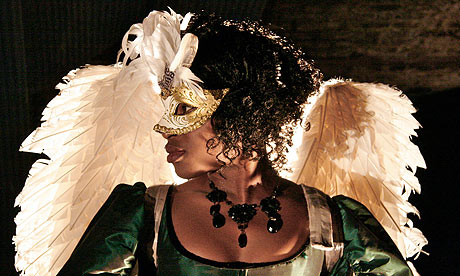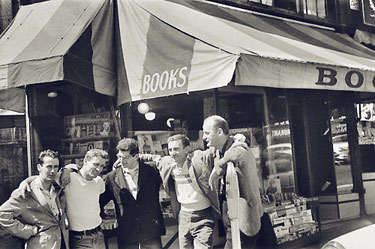Such an outburst from the writer, whose mastery of “elegant Latinate constructions” had wowed the literary world, served only to publicise the dispute and encourage his Greek critics. By the time the shooting of the Corelli movie began in earnest in Cephalonia earlier this year, the film-makers were having to issue public assurances that they would not be re-opening the wounds of the civil war or repeating what the island’s resistance veterans regard as de Bernières’s defamation of their movement. Most critics on the island have accepted the undertakings that the film will be a straightforward love story and avoid the controversy surrounding the book. They have also been mollified by the fact that the scriptwriter is Shawn Slovo, daughter of Ruth First, the murdered anti-apartheid heroine, and Joe Slovo, former communist and ANC leader.
“Dr Zhivago is the movie we’re making,” producer Tim Bevan says. “It’s a big epic romance. The war is the backdrop to the movie and politics gears things up, because it’s about life and death. But the argument over the politics and the civil war is as dull as ditchwater as far as we’re concerned. What this is about is maintaining an emotional through-line for 100 minutes and making them cry a lot.” The script was, the film-makers say, finalised before they started shooting, but director John Madden has since moved further away from the book. Along with the civil war, they have jettisoned several other of de Bernières’s most contested tales and characters, including the psychopathic partisan leader, Hector, and all the mainland partisan atrocity scenes. And, in contrast to the novel, Cephalonian andartes are indeed shown fighting side by side with the Italians against the Germans. The island authorities nevertheless remain nervous about how the movie will turn out. “If they screw us,” one senior official says of the film-makers, “I don’t know what we’re going to do.”
Meanwhile, excitement about the film on the island is being fanned in the Greek media: Robert de Niro is spotted visiting the set, Madonna is rumoured to be having dinner with Nic Cage - though it turns out she is only holidaying in nearby Ithaca. In the fishing village of Aghia Efimia, the Spanish actress Penelope Cruz, who plays Pelagia in the film, is reading El Pais in jeans in a cafe by the harbour, while John Hurt pays the bill at his regular table. Cage, who is generally surrounded by flunkies and has been busy mastering the mandolin, has not dropped in for a while. Until a couple of months ago, this was Cafe Dimitrios, but now it is Captain Corelli’s Cafe, proclaimed in red-and-gold lettering above the awning. “We changed it to please the film company,” explains the cafe’s Peter Anastas. “The book has helped business and we hope the film does, too.” But even he is sceptical about de Bernières’s story. “That stuff the author wrote about the andartes and the communists is fantasy, but it doesn’t matter because we know it’s not true.”
The problem of novels and films that play fast and loose with history - and the grey area where artistic licence predominates - is a familiar one. In earlier editions, de Bernières explained: “Much of what I have written consists of hearsay tempered with myth and hazy memory, which, of course, is what history is.” It is little wonder perhaps that the Princeton university historian Mark Mazower, author of a prize-winning account of wartime Greece, should have written recently: “De Bernières has a rather jaundiced, indeed biased, attitude towards the Greek left, and his understanding of what history is is not much better.” But unlike other controversial historical movies such as The Patriot or Braveheart, Captain Corelli’s Mandolin deals with events that took place in living memory - and the onslaught from survivors has now forced de Bernières on to the back foot.
When first privately taken to task after the book’s initial publication, according to one critic, the author explained he had obtained some of the historical background from Alexandros Rallis, then working at the Greek embassy in London and a relative of Ionnis Rallis, Greece’s quisling dictator under the Nazis. But, despite offering “particular thanks” to Rallis in the book’s acknowledgements, de Bernières insists that the embassy official provided only the date of a Greek Orthodox Easter during the war years and nothing else. Another of his cited sources is Helen Cosmatatos, an English-born Miss Marple character, who married a Cephalonian aristocrat and has lived in Argostoli since 1936. She stayed on the island throughout the war and is founder and guiding light of the magnificent Corgialenios cultural history museum.
Cosmatatos gave de Bernières reading lists and, according to her staff, corrected drafts of the novel. She has little love for the Greek left and her husband was arrested - though not mistreated, she says - by the resistance after the liberation. But even she now seems anxious to distance herself from the finished product. “I know a good bit of it is not true, but it’s not my business to start having arguments. Allowing the book to be translated into Greek, that was asking for trouble. I even had people in here from the government, cabinet ministers from Cephalonia, waving the book around. They were furious about it.”
In fact, de Bernières had already had to agree that some of his “language and opinions should be moderated”, as he put it, when the Greek edition of the novel was published. The following passage, for example, was deemed too much for Greek readers to take, and was excised on the advice of his publisher: “In Cephalonia the communists began to deport awkward characters to concentration camps; from a safe distance they had watched the Nazis for years, and were well-versed in all the arts of atrocity and oppression. Hitler would have been proud of such assiduous pupils.”
Last month, the novelist began a more public, if limited, climbdown over Corelli, conceding he could have been wrong about the resistance. Whether in response to the pressure of the veterans’ campaign on the film-makers or not, he explained that, while he “had not actually changed my mind about what I think is the truth, I had to bear in mind the possibility that I might be wrong”. He did not, he said, want to stir up bad blood and the story of the resistance was “extremely complex” - adding, for good measure, that he regarded the persecution of communists in Greece after the war as an “absolute disgrace”. In an email to the Guardian last week, he said he is “no longer as sure of everything as I once was,” and would be prepared to change his mind on the “production of convincing evidence”.
Both de Bernières and Corelli film producer Kevin Loader like to emphasise how difficult it is to establish what really happened in Cephalonia during and after the German occupation. “People have been telling each other stories for years and they give completely contradictory versions of events,” Loader says. There are, in fact, extensive German, British, Italian and Greek records of the period and both Greek and foreign historians have written substantial accounts. But if there is one person more than any other who is in a position to know the truth of the events described in Captain Corelli’s Mandolin, it is the former general manager of the Italian automobile club, Amos Pampaloni. For he, if anyone, is the real Captain Corelli.
Now 89, Pampaloni lives with his wife, Marisa, in a flat near the sports stadium in his home town of Florence. He is a great bear of a man at 6ft 3in, alert and courteous to a degree. The son of a socialist railway official, he resisted pressure in the 30s to join the ubiquitous fascist organisations of Mussolini’s dictatorship, though he was not involved in the political underground. Like de Bernières’s self-sacrificing gay giant, Carlo Guercio, he was called up and sent to the front when Italy invaded Greece in 1940, reluctantly fighting Mussolini’s war of aggression through the bitter mountain winter in the teeth of dogged Greek resistance. And like de Bernières’s hero, Captain Corelli, Pampaloni was promoted to captain in the 33rd artillery regiment, Acqui division, and posted to Cephalonia as part of the occupation force. In fact, he was the only artillery captain on the island.
Like Corelli, Pampaloni had an affair with a Cephalonian girl - though, whereas Corelli fell in love with Pelagia, the daughter of a doctor, Pampaloni’s relationship was with Maria, a schoolteacher’s daughter. Like Corelli, Pampaloni played a central role in the decision to launch the attack against German troops in Argostoli on September 13, 1943, after days of dithering by the generals. But whereas de Bernières has a captain Fienzo Appollonio giving the order to fire on a flotilla of German landing craft, all the evidence - and Pampaloni’s own testimony - suggests that it was he who took the initiative and gave the command to the artillery battery: “Fuoco!” There was a Renzo Appollonio who took part in the barrage, but he was a lieutenant under Pampaloni’s command, stationed further down the hill and not in a position to see the German targets.
Like Captain Corelli, Pampaloni was shot and left for dead by the victorious German troops amid the corpses of his fellow Italian soldiers, but miraculously survived, his wounds successfully treated by an untrained village doctor. But in an ironic twist to Corelli’s dismissal of the Cephalonian andartes as “bandits that loot the villages”, Pampaloni was actually rescued by the resistance movement and after his recovery joined the very ELAS guerillas held in such contempt by de Bernières - fighting with them against the Germans on the Greek mainland for a year and returning with the ELAS 7th brigade to help liberate Cephalonia, where he was wounded again, in the autumn of 1944.
He went back to his job at the automobile association in Italy after the war, only to find himself eventually facing a court-martial - brought at the insistence of the father of one of the victims of the Cephalonian massacres - for his decision to open fire in September 1943. Triumphantly cleared, he went on to be decorated by the Italian government for his heroism, hailed in the official citation as the “soul of the resistance in Cephalonia”. To this day he remains a folk hero on the island.
Leaning forward in an armchair in his Florence living room, Pampaloni recounts with mesmeric clarity his experience of the Cephalonian massacres - the centrepiece of the Corelli story. His battery had been moved to the village of Dilinata, where he and 80 other Italians were surrounded by German troops at dawn on September 22, 1943. “After the soldiers had disarmed us, they began taking off our watches, chains, wallets and belts. I protested to the captain in charge that it was not permitted to take prisoners’ personal effects. He replied through an interpreter: ‘Not from prisoners, but from traitors, yes.’ They told us to stand in a row and I was made to go at the end of the line, Lieutenant Tognato next to me. He called out to the soldiers to say their prayers, but I had no idea what was about to happen and I told him not to demoralise the men.
“The captain said, ‘Let’s go’. I took a step, he raised his pistol and fired a single shot at me. The bullet went through my neck and I was thrown to the ground by the impact. That must have been the signal for the massacre, because they then opened up with machine guns and I could hear the cries of our boys calling ‘mamma’ and ‘Dio’. I never lost consciousness and felt one of the Germans take off my watch, which they had missed earlier because it was on my right hand. After about 10 minutes I heard the Germans march off, laughing and singing.” With Tognato’s body on top of his legs, he lay motionless, losing blood. “Soldiers are like a family and I worried that maybe I was responsible for what had happened,” he says, breaking down. “The thing I remember is the terrible feeling of thirst and weakness.”
Eventually, he was found by a Greek boy, who brought him water and milk, and partisans bandaged his wounds. Stumbling towards Argostoli through the night to avoid German patrols, he eventually met a young woman resistance member, Maria Constantakis, who convinced him to hide and have his wounds treated at the house of her father, a village priest. Nicos Fokas, younger brother of the partisan Spiros, contacted the andartes at a base on Mount Aenos, where Pampaloni was taken a week or so later.
De Bernières denies that Pampaloni was the model for Captain Corelli: the character was, he says, inspired by his father’s war stories from his time with the British 8th Army in Italy. The film producer Kevin Loader believes Corelli is an “amalgam of Pampaloni and Appollonio”, but adds that, while they were anti-fascists, de Bernières’s hero is “not remotely interested in politics, or being a soldier for that matter”. De Bernières maintains he “didn’t know enough about Appollonio and Pampaloni at the time of writing to use them as a source of character”, adding, “one of the problems of writing historical novels is that people deluge you with information when it is too late to be of any use”.
Nevertheless, de Bernières does cite a 60s Italian novel - The White Flag, by Marcello Venturi, which is explicitly based on Pampaloni’s story - as a source in his own book’s list of acknowledgements. De Bernières’s plot mirrors, to some extent, that of The White Flag - an Italian artillery captain on Cephalonia befriends a German and has an affair with a Greek girl, then becomes engulfed in the Italian-German confrontation of September 1943 and survives the subsequent massacres - though Corelli is a much longer, more ambitious and complex novel. De Bernières says he “read The White Flag after I had already decided on the bare bones of the story… I was slightly put off my own project when I found that The White Flag was about an Italian and a Greek girl, but I eventually decided that the important thing was to do it differently and to do it well.” In any case, he says, reeling off a list of other influences, “intertextuality” is the stuff of post-modern fiction.
Although aware of the Corelli book and film, Pampaloni himself had not read de Bernières’s novel until earlier this month when we approached him; he had not been able to find it previously because it is published in Italian under another title: Una Vita in Debito (A Life In Debt). He begins by looking for something positive to say. “What is right in the book is that it shows war is a terrible, ugly thing and, just as we have seen in Kosovo, war is always unjust and violence always leads to more violence. But, like many Cephalonian critics, he winces at what he sees as the book’s condescending national stereotyping of both Greeks and Italians, taking exception to the scenes of communal defecation and leisured mandolin-playing or opera-singing under conditions of military occupation - “in fact, generally speaking, Italians don’t play the mandolin, except in Naples”. The book is full of hopelessly unrealistic caricatures, he says. “Judging by what he has written, Louis de Bernières seems to regard the Italians and the Greeks as inferior races, as many British people did during the time of the empire.”
Speaking in a voice husky from a throat cancer operation - rather than the 57-year-old bullet wound in his neck - the Italian veteran’s most withering comments are directed towards the novel’s portrayal of the Greek resistance. He dismisses the suggestion that it was the British-backed EDES group that took on the Germans as laughable, and confirms that Cephalonian ELAS partisans did indeed fight and die alongside the Italians during September 1943. “De Bernières says the andartes used to kill peasants if they didn’t hand over food, which is totally untrue. In my experience, 90% of the population welcomed them and helped them willingly.”
Nor does he recognise De Bernières’s portrayal of the ELAS andartes as torturers and rapists - on the contrary, he insists, the movement’s discipline was ferocious over the treatment of women, recalling a highly-valued doctor in his partisan unit who was executed after he was accused by a Greek girl of rape. The guerilla war against the Germans was brutal, he concedes. Shortly after he joined ELAS on the mainland, he was shocked to see andartes cutting the throats of captured German soldiers. “But you have to understand that in a partisan war you cannot take prisoners and each bullet is precious. It can save someone’s life.
“I am on the left, but I am not a communist. However, the picture de Bernières paints of the Greek partisans is unacceptable and completely wrong. To speak of the Greeks as barbarians, who killed for the sake of killing, is not only wrong and unjust, it is pandering to racism. I lived among them for 14 months and those months were an unforgettable experience, because of the partisans’ sense of solidarity, kindness, altruism and fraternity.”
Pampaloni’s happiest memory of Cephalonia is his arrival at the partisan base on Mount Aenos after the massacre. “I cannot describe the warmth of the welcome I was given, or I will cry. I was at the end of my tether and all of them, men and women, embraced me, washed my face and feet, and gave me ouzo and fruit. Formally, we had been enemies a month before and now they treated me like this.” In September, Pampaloni will return to the island for a commemoration of the Nazi slaughter with his fellow survivors and Greek resistance veterans. The bond between them has endured for more than half a century.








